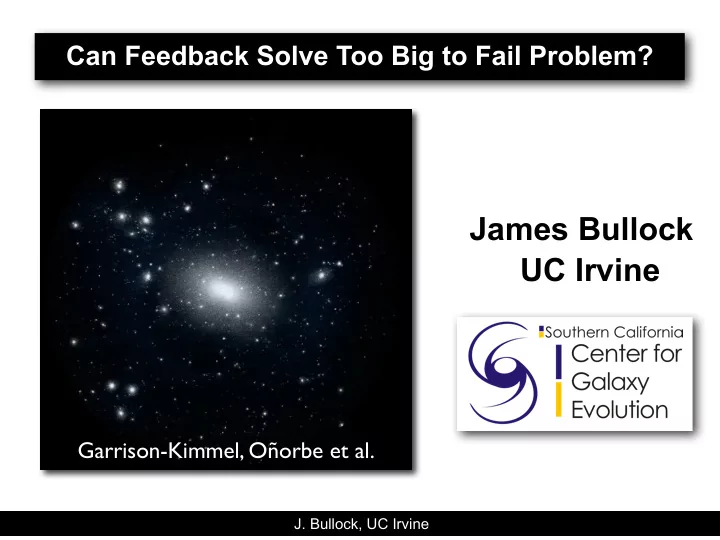

Can Feedback Solve Too Big to Fail Problem? James Bullock UC Irvine Garrison-Kimmel, Oñorbe et al. J. Bullock, UC Irvine
Collaborators Shea Garrison-Kimmel Mike Boylan-Kolchin Jose Oñorbe Jaspreet Lally Manoj Kaplinghat J. Bullock, UC Irvine
dSphs are DM dominated => easy to interpret “Faint” dSphs Galaxy Clusters Draco, Ursa Minor L~10 5 L sun M dyn /L ~200 “Bright” dSphs Fornax, Leo I L~10 7 L sun GCs M dy n/L ~9 dEs/ Ellipticals Wolf+10; Tollerud+11 J. Bullock, UC Irvine
Boylan-Kolchin et al. 2012 J. Bullock, UC Irvine
Boylan-Kolchin et al. 2012 Fornax: M dyn /M* ~ 3.5 DM DM Leo I: M dyn /M* ~ 4 J. Bullock, UC Irvine
Boylan-Kolchin et al. 2012 Why nothing here? V max >~30 km/s? Fornax: M dyn /M* ~ 3.5 DM DM Leo I: M dyn /M* ~ 4 J. Bullock, UC Irvine
Six Aquarius Halos: ~10-20 massive failures each Boylan-Kolchin et al. 2011a,b J. Bullock, UC Irvine
M31 dSph population looks the same Tollerud, Boylan- Kolchin, JSB, in prep Erik Tollerud J. Bullock, UC Irvine
Reduce Milky Way Halo Mass? Option 1 Milky Way significantly less massive than 1.10 12 M sun ( <~7.10 11 M sun ) ✓ ◆ M v N extra ' 5 10 12 M � Would require: 1. LMC and LeoI both unbound (vanishingly rare in cosmological simulations) 2. SMC and LMC extreme outliers in subhalo mass function 3. M31 ~3 times more massive than MW (timing argument) 4. Majority of recent dynamical mass estimates of MW halo biased high Boylan-Kolchin et al. 2012 J. Bullock, UC Irvine
Tides from disk? Option 2 Would need to bring massive subhalos preferentially close to disk. Leo I, for example, has likely never been close to the disk, r_peri ~ 70 kpc (Besla et al., in prep.). How about field dwarfs? J. Bullock, UC Irvine
Ferrero, Abadi, Navarro, Sales & Gurovich 2011 Similar problem with field dwarfs Expected from Abundance Matching Mvir ~ 10 10 Msun Observed rotation curve Mvir ~ 10 9 Msun J. Bullock, UC Irvine
Feedback? Option 3 Feedback: need to remove/redistribute ~5.e7M sun of DM within ~500pc. Mass loading is a problem: Gas mass removed mass-loading factor, ~1.e6 Msun ~5.e6Msun typically ~1-5 Maybe if the blow-out is cyclic this helps? Mashchenko et al.; Pontzen & Governato Boylan-Kolchin et al. 2012 J. Bullock, UC Irvine
Feedback? Numerical Experiment Fixed potential w/ variable mass dial r 1/2 = 500pc Live DM Halo Garrison-Kimmel et al. J. Bullock, UC Irvine
Numerics/Set up Remove baryon fraction of mass from DM only runs: => ~3 km/s lower MW sats + Garrison-Kimmel et al. J. Bullock, UC Irvine
Numerics/Set up Run in isolation for 5 Gyr m dm = 8.10 3 M sun ퟄ = 10pc m dm = 3.10 4 M sun ퟄ = 70pc MW sats m dm = 1.10 5 M sun ퟄ = 120pc MW sats + Garrison-Kimmel et al. J. Bullock, UC Irvine
Numerics/Set up Run in isolation for 5 Gyr m dm = 8.10 3 M sun ퟄ = 10pc m dm = 3.10 4 M sun ퟄ = 70pc MW sats m dm = 1.10 5 M sun ퟄ = 120pc MW sats + ~best current z=0 hydro runs of MW systems Garrison-Kimmel et al. J. Bullock, UC Irvine
Numerics/Set up Run in isolation for 5 Gyr m dm = 8.10 3 M sun ퟄ = 10pc m dm = 3.10 4 M sun ퟄ = 70pc MW sats m dm = 1.10 5 M sun ퟄ = 120pc MW sats + ~best current z=0 hydro runs of MW systems Garrison-Kimmel et al. J. Bullock, UC Irvine
Galaxy Mass With Time 10 8 1 blow-out of 10 8 M sun (M sun ) 10 7 10 blow-outs of 10 7 M sun 0 Time Galaxy Mass With Time (M sun ) 10 7 0 Time J. Bullock, UC Irvine
10 blow-outs of 10 7 M sun 1 blow-out of 10 8 M sun Garrison-Kimmel et al. J. Bullock, UC Irvine
1 blow-out of 10 8 M sun 3 blow-outs of 10 8 M sun 10 blow-outs of 10 8 M sun 1 blow-out of 10 9 M sun Garrison-Kimmel et al. J. Bullock, UC Irvine
Garrison-Kimmel et al. J. Bullock, UC Irvine
Ursa Minor Fornax M wind /M gas = 1-10 M wind /M gas = 1-10 Garrison-Kimmel et al. J. Bullock, UC Irvine
Garrison-Kimmel et al. J. Bullock, UC Irvine
Towards more realistic feedback Use Hopkins, Quartaert, and Murray 2012 scheme / Gadget3 - Self-consistent (resolved) ISM. Hydro never turned off. Oñorbe et al. - SNe (II & Ia), Radiation pressure from stellar winds, Photoionization (HII Regions) - Energetics/timing from stellar evolution models, fine-structure cooling to ~100K Dwarf Zoom M ⇤ = 2 × 10 6 M � m dm = 1 . 3 × 10 3 M � DM-only run M gas = 9 × 10 6 M � (f b subtracted) m gas = 1 . 7 × 10 2 M � ~2.5% of baryons remain ✏ res = 14pc Full model z=0 hydro J. Bullock, UC Irvine
Conclusions • Feedback not a compelling solution to Too Big to Fail dwarfs problem • Need very high resolution (~10 pc) to really address the problem • Cyclic bursts don’t seem to help: ‣ DM removal per baryon blown out is similar (a little less) than single bursts • What can we do to fix the problem in context of WIMPy CDM? ‣ Smallest possible Milky Way mass AND ‣ Wind-loading factors >~ 10 AND ‣ Tides matter a lot more than expected • See Miguel Rocha’s talk on CDM with self-interaction similar to nucleon-nucleon scattering (~ 0.1 cm 2 /g) => constant-density cores. J. Bullock, UC Irvine
Recommend
More recommend